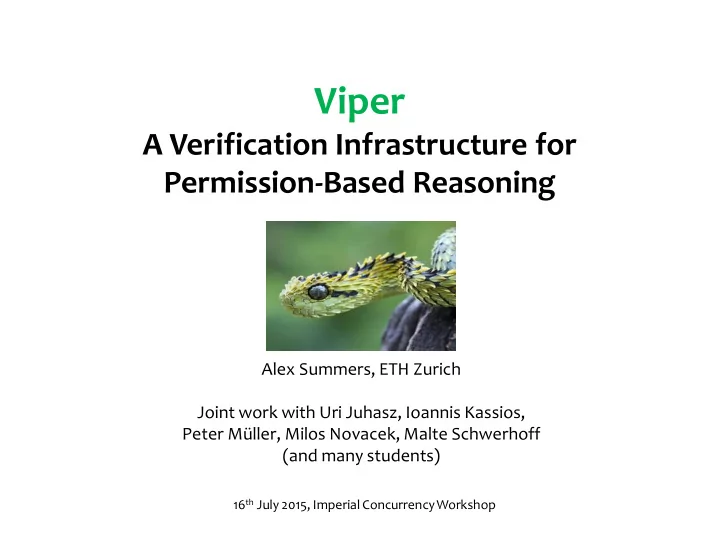

Viper A Verification Infrastructure for Permission-Based Reasoning Alex Summers, ETH Zurich Joint work with Uri Juhasz, Ioannis Kassios, Peter Müller, Milos Novacek, Malte Schwerhoff (and many students) 16 th July 2015, Imperial Concurrency Workshop
Verification via Automatic Provers • Last 10 years: rapid progress in Fron ont-end nd automatic tools for first-order tool ol logics (SMT solvers, provers) generates • Intermediate Verification Int ntermedia iate Languages: e.g. Boogie and Why Verif ific ication ion • Provide common infrastructures Lang nguage for building program verifiers verified by • Many success stories and tools Back-end nd • tool ol Microsoft Hypervisor (VCC) • Device-drivers (Corral) • .. and many more, e.g., Why3, ✔ aut utom omatic ic ✘ prov over GPUVerify, Spec#, Dafny, Vericool, Krakatoa , etc….
Permission-Based Reasoning • Separation Logic (and others): custom logics for heap reasoning z.g x.f • control of ownership/sharing of this.f y.f partial heaps (heap fragments) • First-order prover technology difficult to directly exploit • Custom verification engines (usually symbolic execution) • Lots of work to implement • Hard to reuse for new work • … fewer tools available
The Viper Project • We have designed Silver: a new intermediate verification language • Fron ont-end nd Reusable native support for tools ols permission-based heap reasoning generates • Few, expressive constructs • Silver The tool infrastructure is called Viper • Includes back-ends (two verifiers) verified by • Some front-end tools also available: Back-end nd • Proof-of-concept translators for tools ols • Chalice, Scala (fragment), etc.. • used for various other projects
Basic Assertion Language • Based on Implicit Dynamic Frames [Smans et al. ’09] • Permission assertions: accessibility predicates acc(e.f) exclusive: similar to e.f ↦ _ in separation logics • • Expressions e may depend directly on the heap • e.g. acc(x.f) && x.f > 0 • Fractional permissions [Boyland’03], e.g. acc(x.f, ½) • allow reading (and framing), not writing • Conjunction && is multiplicative for permissions e.g. acc(x.f, ½) && acc(x.f, ½) acc(x.f, 1) •
Silver primitives: Inhale and Exhale • A statement inhale A means: • all permissions required by are A gained • all logical constraints (e.g. x.f > 0) are assumed • A statement exhale A means: • check, and remove all permissions required by A • all logical constraints (e.g. x.f > 0) are asserted • any locations to which all permissions is lost are implicitly havoced (their values are no-longer known) • Can be seen as the permission-aware analogues of assume/assert statements used in first-order verification • used to model ownership transfer of partial states • cf. “produce” and ”consume” in symbolic execution
Example : Encoding Locks (CSL-style) class C { int [ ] data; int count = 0; monitor invariant this.data ↦ _ * this.count ↦ _ void Foo( ) { acquire this ; int i = data.length; while ( 0 < i ) invariant this.data ↦ _ * this.count ↦ _ invariant holds ( this ); { ... ; i = i – 1; } count = count + 1; release this ; } } 25
A few powerful Viper features …. • Paired assertions [A,B] • A used when inhaled, B used when exhaled • mismatches: external justification / proof obligations • Quantification over local state forallrefs[f] x :: • non-standard for separation logics (but handy)
Example : Two-state invariants class C { int [ ] data; int count = 0; monitor invariant this.data ↦ _ * this.count ↦ _ && this.count > old (this.count) void Foo( ) { acquire this ; int i = data.length; while ( 0 < i ) invariant this.data ↦ _ * this.count ↦ _ invariant holds ( this ); { ... ; i = i – 1; } count = count + 1; release this ; } } 27
A few powerful Viper features …. • Paired assertions [A,B] • A used when inhaled, B used when exhaled • mismatches: external justification / proof obligations • Quantification over local state forallrefs[f] x :: • non-standard for separation logics • State snapshots, labelled “old” expressions • Custom predicates, heap-dependent functions [ECOOP’13] • fold/unfold for predicates, functions mostly automatic • Constrainable permissions [ VMCAI’13, FTfJP’14] • Alternative to fractional permissions (angelic amounts) • “Magic wand” support [ECOOP’15] • Powerful connective from separation logic • Custom domains, sets and sequences, quantifiers
Verification of Silver Code (back-ends) Silver code verified by Carbon Silicon encodes in Boogie queries (Microsoft) queries Z3 (Microsoft) Verification Symbolic Condition Execution Generation 31
Verification of Silver Code (back-ends) weakest precondition calculation given to read by calculates VCG Program Verifier WPs Prover Query prover once with full information (encode heap) symbolically execute every path through every method maintains read by Program Verifier Symbolic State σ SE used by Prover query prover at every step: is next statement executable? σ 1 σ 2 σ 3 σ 4 σ 5 Query prover often with limited information (no heap) 32
Tool Availability and Future Work • Core tools released (open-source) in September 2014: http://www.pm.inf.ethz.ch/research/viper.html https://bitbucket.org/viperproject • we have (public!) issue trackers for known problems • Some advanced features are in the pipeline (but ask) • Building / supporting new tools by translations into Silver • SL, dynamic frames, invariants, rely-guarantee, types • More- advanced program logics? Weak memory? … • Also interested in work we cannot encode (yet … ) • Make tools to implement your cool research with Viper • coalesces much formal and practical past research • users can focus on the aspects relevant to their work
Any questions? Java ? Scala2Silver (VerCors project - (UTwente) Marieke Huisman) front-ends OpenCL Chalice2Silver (UTwente) gene rate infer additional Sample Silver specifications verified by Carbon Silicon encodes in back-ends Boogie queries (Microsoft) queries Z3 (Microsoft)
Recommend
More recommend